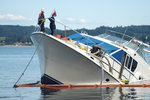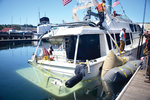It took workers more than 48 hours to salvage the Silver Lining yacht from where it crashed south of the Hood Canal floating bridge July 24 and haul it to dry dock in Port Townsend three days later.
This item is available in full to subscribers.
We have recently launched a new and improved website. To continue reading, you will need to either log into your subscriber account, or purchase a new subscription.
If you had an active account on our previous website, then you have an account here. Simply reset your password to regain access to your account.
If you did not have an account on our previous website, but are a current print subscriber, click here to set up your website account.
Otherwise, click here to view your options for subscribing.
* Having trouble? Call our circulation department at 360-385-2900, or email our support.
Please log in to continue |
|


It took workers more than 48 hours to salvage the Silver Lining yacht from where it crashed south of the Hood Canal floating bridge July 24 and haul it to dry dock in Port Townsend three days later.
The liveaboard owners of the 65-foot vessel, David and Janel Silver of Bainbridge Island, were headed north in the canal Tuesday afternoon and steered under an elevated portion of the bridge where smaller boats can pass.
But that’s also an area where a reef of rocks called The Sisters lie — and the Silver Lining struck them, immediately taking on water.
They radioed for help at 3:46 p.m. and then the eight people aboard — the Silvers, their children and grandchildren, aged 4 to 9 — escaped on an onboard skiff.
“I don’t know what happened; it was all very fast,” said Jalene Carpenter, the couple’s daughter, who was visiting from Omaha, Nebraska, with her two children and two nieces. “We were pretty far away from the markers. Obviously we hit something.”
“There’s a reef there,” said Capt. Roger Slade of TowBoatUS “You have to be well aware of that, consult your charts and be aware it’s there.”
There’s nothing simple about salvaging a million-dollar yacht that sinks. Here’s the timeline:
July 23
After the yacht grounded Tuesday afternoon, the incoming tide carried the sleek luxury craft south toward the west shore Bridge Haven community, where crews from TowBoatUS of Port Hadlock pushed it to shallower water and anchored it by sunset.
Slade said the salvage operation got off to a confusing start because his team was told the vessel was on the northeast side of the bridge but was ultimately found near the southwest end. Additionally, this time of year, salvage company resources are stretched thin; he had to forego two other operations to address the Silver Lining.
“All in all, it’s pretty amazing we actually did it,” he said. “But there were no injuries, no pollution and the boat’s on the yard. That to me is success.”
State Department of Ecology Spill Response Team members ascertained no fuel was leaking from the damaged boat.
Andrea Unger with the spill response team said it was unknown if the owners would be fined for their part in the incident, noting that recreational boats are held to different standards than commercial vessels.
“We rate them points, on a matrix,” she said July 24 at Bridge Haven, noting that the incident was not reported to the Coast Guard’s National Response Center for three or four hours. “It’s been one-and-a-half days, and a report is supposed to be ‘immediate.’ But did that hinder our response? No.”
There was a shimmer of a silver lining for the Silver Lining.
“I’m happy they got out,” Unger said. “I’m happy they have insurance; I’m happy about a lot of things.”
David Steele, owner of Rocky Point Oyster Company just north of the staging grounds of the salvage operation was on scene as well, worrying about potential fuel spills, as he is just now harvesting oysters and clams from his 50-acre farm.
“We’re concerned,” he admitted, “but it seems to be well contained.”
Some on the dock in Port Townsend noted the irony that the Silver Lining would be dry-docked at its place of origin.
According to Slade, the mold of the hull was built by Admiralty Supply in Port Townsend. The fiberglass and remaining build-out was done in Marysville.
The boat, made in 1997, was valued at $1.65 million at the time; Slade estimated the price of a new one at almost $3 million.
July 24
Bridge Haven residents came and went throughout the day to watch the salvage operations.
Crews from Seattle-based Global Diving and Salvage first sent a dive team into the water to assess the damage and plug up both the built-in through-hull holes (for various ship systems) and those created by the crash — which alone took about four hours.
The port side propeller and rudder had been pushed up and forward into the hull of the boat during the crash, and both rudders were severely bent.
The Global Diving team spent the remainder of the day pumping water from the vessel, which sat in the water, its bow pointing skyward, as residents watched from their decks not 50 yards away.
Such a situation requires constant vigilance throughout the day as an array of elements — the changing tides, the weather, the “action” of the boat in response and numerous potential unforeseen things — usually come into play, said Katy Stewart, project manager with Global Diving.
“There’s no such thing as a typical salvage,” Slade said. “It is what it is. I’m happy it’s over.”
Crew members communicated using hand signals, radios, cell phones and yelling to one another throughout the operation — one even swimming ashore to discuss a problem with Stewart.
That problem was the water removal on Wednesday, which was going fine — until it wasn’t.
The Silver Lining was listing to port, forcing workers to stop operations at 4:20 p.m. and reevaluate the situation. Unger noted, too, that by law, the divers can only be underwater for a certain length of time before a second team must be called in or the divers allowed to rest until the next day.
This was when the team moved to Plan B: huge neoprene “lifting bags” placed under and alongside the wreck to lift the stern they believed was embedded in the sand below.
The hours ticked on — 8 p.m., midnight — and still the boat wouldn’t budge.
Stewart said they sent down divers four times to plug other holes before the bags were able to pop the yacht from the mudflats below.
Once it was afloat, the crews began the long process of removing the fuel from the tanks. The owners originally estimated 300 gallons onboard; crews ended up transporting 755 gallons — at 150 gallons per trip — to a marina near Shine.
The 26-hour operation to get the boat floating will likely cost tens of thousands of dollars, Stewart said.
“Divers ... it adds up fast,” she said. “They were getting double-time for the majority of that project.”
July 25
By Thursday morning, it was time for the two- to three-hour haul to Port Townsend, where a heavy-duty travel lift would remove the yacht from the water.
Two of Slade’s boats slowly towed the damaged yacht up Hood Canal, around Marrowstone Island, and guided and nudged it along in the channel at Boat Haven to avoid striking nearby boats.
But the incoming tide and the Silver Lining’s own momentum pushed the 60,000-pound yacht — heavier yet with all the water still aboard — into one of the salvage boats that in turn punctured a port-side lift bag.
“I felt so helpless not being there,” Stewart said as she watched the incident unfold on video. “It was exciting, and not the good kind.”
The yacht began to sink again — just yards from the travel lift.
Crews on board fired up their pumps as salvage boats pushed the yacht to the travel lift. Most of the boat’s body made it into the travel lift’s cradle, but the water was still winning.
One man aboard said the water in the bedroom below had been up to his ankles when they started pumping, and rose swiftly to waist-deep. Two more pumps were started up and by 3:30 p.m., the yacht was righted, hoisted and left to drain before being transported to the yard for further evaluation.
Obvious damage included that to the two propellers, the shafts that drive them and the rudders. There were scuff marks on the keel, from which water flowed freely, as well.
“The props were something special; just mangled,” Stewart said. “When I heard about how much the rudder was bent, I was worried they’d be turning around in circles. But they were able to compensate.”
Slade and Stewart said they believed the insurance company would declare it a total loss.
“To restore the interior, all the electrical, the shafts — the props are gone,” Slade said. “It’d be a million-dollar job.”
“But (the operation) went well,” Stewart said. “It was difficult, but we got there. It’s out of the water; that was the goal.”
The family
The Silvers lost everything they owned — with the exception of David Silver’s wedding band, which salvage operators saw on a table next to the bed and retrieved for him.
“That was super nice,” Carpenter said. “He was very grateful.”
But they lost everything else: clothing, photo albums, laptops — everything that would be in a regular house, she noted. “It was their home.”
Recovery will take awhile, she admitted, and the Silvers don’t yet know what to do about the yacht.
“We lost everything — absolutely everything,” Janel Silver said. “We lived on it for seven years.”
“We’re still on Day One — we just got (the kids) clean underwear,” Carpenter said. “We didn’t have shoes. It happened so fast, there wasn’t any time to get anything.”
The Silvers are members of several yacht clubs in the area and fellow members have come out in droves to help.
“They have great community support,” Carpenter said. “We’re taking one day at a time. They’re getting all squared away. It’s just still fresh and hard to deal with. But everyone’s safe and that’s all that really matters.”